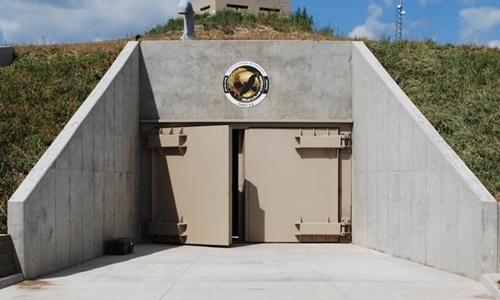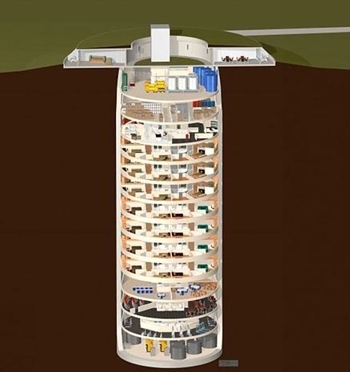When referring customers about the Kansas apartment complex, Larry Hall emphasized the important detail: the ability to survive the end of the world.
Hall, the project director of Survival Condo, has converted an old military nuclear missile tunnel into a 15-floor underground apartment complex. He is a leader in the group of new real estate developers, investing in the belief of doomsday.

Entrance to the Survival Condo shelter in Kansas, USA Photo: Survival Condo Project
Americans for generations have prepared the worst scenario. They built bunkers during the Cold War and stored them in the basement before Y2K (computer crashes in 2000). But in recent years, disaster preparedness has grown into a multi-million-dollar business, fueled by a host of new threats, from climate change to terrorism, attacks. network and civil unrest.
Tunnel builders and brokers are key players in this area. During the Cold War, the military spent billions of dollars building nuclear warheads and hiding them in missile silos across the country, mainly in Kansas, Nebraska, Oklahoma and New Mexico. These vaults no longer contain weapons and they are for sale at relatively cheap prices.
Hall bought the vault for $ 300,000 in 2008 and spent nearly $ 20 million to turn it into a 12-unit condominium. The tunnel was about 2.7 m thick, strong enough to withstand the direct impact of a nuclear bomb explosion. Hall equips the building with 5 air filters, installs three backup power supplies, three separate water supplies and a water filtration system. The starting price of an apartment is 1.3 million USD, the monthly operating fee is 2,600 USD. Hall said he started selling around 2011 and all apartments were sold within months.
For Hall and many of its peers, this is more than just business. "I'm saving lives. I feel great," Hall said.
Many people are skeptical about the project, including John W. Hoopes, a professor of anthropology at the University of Kansas. He accused investors of taking advantage of the fear that danger was imminent and that only a few people could save themselves and their families if they were prepared. "If you can scare people, you can sell them everything, including the bunker," Hoopes said.
However, survival houses not only attract obsession-obsessed people, but also those who simply want to "stay hidden" or want to be self-employed if risks arise.
Kiki Bandilla, 52, an insurance worker in Castle Rock, Colorado, said she was not the type of person to think "it is about to fall." However, she participates in the Fortitude Ranch survival community, which prepares underground tunnels, stores food and weapons, as it is a reasonable insurance policy.

A 15-story drawing of the Survival Condo shelter in Kansas, USA Photo: Survival Condo Project
"I don't want to depend on anyone, be it government, food or medicine. I'm interested in projects not because of fear but because I want freedom," she said.
In recent years, Prepper Camp, an exhibition of disaster preparedness and housing for three days in North Carolina, has become a destination for those who fear the end of the world. PrepperCon, an organization outside Salt Lake, Utah, also attracted thousands of visitors. High-end real estate agents look for a place to hide for wealthy tech entrepreneurs in California or a Texas oil chief.
In Las Vegas, the underground tunnel built by Girard Henderson has a luxury kitchen with furniture and a wood burning fireplace, sold for $ 18 million. In Colorado, a site that used to be an arsenal of 800-meter-long tunnels was sold for $ 4.2 million.
In Indiana, property developer Robert Vicino converted a former government facility into an underground mansion named Vivos. He describes it as a fully furnished 4-star hotel. He also bought 575 old weapons bunkers in South Dakota with the ambition of making it the largest living community on Earth.
Customers believe society is increasingly vulnerable to large-scale disasters. Tom S., 69, who lives outside Atlanta, works in the field of information technology, bought a Vivos vault after growing concern about political unrest.
Recently, Hall, the project manager of Survival Condo, bought a second tunnel in Kansas to continue making it a living building. Hall said among the potential customers were representatives of the Saudi military, who asked him to outline plans to build a helicopter pad and an underground mosque. The Saudi Embassy in Washington declined to comment on this matter.
The construction of the new bunker, three times larger than the first one, now takes up most of Hall's time. "There is so much to do and apocalypse can come at any time," he said.



 MariaVallejo
MariaVallejo







